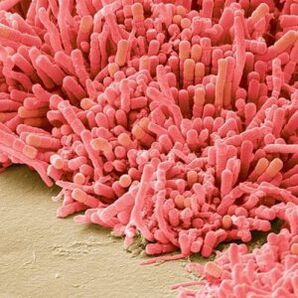If papillomas appear on the visible areas of the body-neck, arms, face, they can be removed to achieve a cosmetic effect. However, if they appear in many areas of the mucosa, such as the throat, they can cause patency disorders and threaten the life of the patient. For the larynx, papilloma can block the airway, causing voice problems or unable to breathe normally; for the bladder, papilloma can cause hematuria. If multiple papillomas are formed on the body, it indicates that papillomatosis has occurred.
Causes of papilloma
In most cases, the occurrence of papilloma is caused by a viral infection-human papillomavirus (HPV), although sometimes papilloma can occur congenital or as a complication of an inflammatory disease.
When HPV enters the human body, its activity usually begins to manifest after a long period of time. Usually, some irritants will cause the activation of papillomavirus, so soft tumors begin to appear on the skin or mucous membranes. The main factors that cause papilloma include: stress, decreased immunity, physical weakness caused by treatment, vitamin deficiency in the body, and skin damage.
Basically, people are infected with papillomavirus. However, home infections may also occur where immunity is low or there are damaged skin areas that may come into contact with HPV carriers. The appearance of papilloma indicates that the activation of the existing virus is equally possible for men and women. Babies may get the virus when they pass through the birth canal of an infected mother.

Classification of HPV performance
Human papillomavirus that infects mucous membranes and skin can be divided into the following forms:
- Clinical forms that can be found in routine examinations: female genitals, papules and papillary warts, exogenous warts, cervicitis and cervical erosion;
- Subclinical form, in which the structures are asymptomatic and invisible, and can only be detected during endoscopy: inverted structures (growing into the mucosa), flat warts and cervical con-shaped tumors;
- Latent form, characterized in that there is no clinic and detection is performed only by analyzing the results;
- Female form or cervical form, which is represented by cervical cancer or different stages of dysplasia.
When women are infected with highly carcinogenic HPV due to sexual contact, the possibility of malignant tumors in the cervical canal increases greatly. When infected with other types of viruses, the possibility of oncology is not very high, but cancerous tumors may develop in the rectum or oral cavity. In men, the possibility of cancer due to HPV exists in the anus, penis, and rectum.
Types and forms of papilloma
It is very important to correctly identify the papilloma that appears on the body. Their type directly depends on the virus strain produced. After the virus enters the human body, it will cause excessive division of skin cells, leading to papilloma.
HPV strains can be carcinogenic and non-carcinogenic. There are more non-carcinogenic variants, and generally speaking, they will not bring any benefit to patients except for external aesthetic discomfort.
can easily remove this form of expression to solve the problem. However, if a tumor appears in the mucosal area, it indicates a serious pathological process. This dislocation means that people have been infected with the cancer-causing HPV strain, so it is very necessary to carry out complex antiviral treatment. To distinguish between different types of papilloma, it is enough to compare them with each other and determine the unique characteristics of one or the other subspecies.

Simple wart
Simple papilloma or wart is the most common type of papillomavirus caused by several strains at the same time. These HPV viruses are not only transmitted through sex, but also through contact and daily life. This has led to statistics showing that 30% of the world’s population has encountered HPV at least once in their lifetime.
Simple papilloma or vulgar warts (common) are usually located on the upper limbs, that is, the hands, but sometimes they may also appear on the body, soles, soles, and fingers. They are characterized by the appearance of such warts on damaged skin due to reduced local immunity. Due to exposure to inferior household chemicals, profuse sweating, various damage to the skin, dermatitis, such papilloma occurs in the sole or palm area.
Common warts look like papillomas of the skin several millimeters in diameter at the beginning of the disease. In this case, the head of the wart body has a uniform and soft texture and rises above the skin surface. It has less pigment, the roots penetrate deep into the skin and absorb nutrients from the blood vessels. As a result of this nutrition, the warts not only gradually become larger, but also the degree of pigmentation gradually increases. Moreover, hair usually grows in the center of this papilloma, which is a variation of normal conditions and does not indicate malignancy.
Flat papilloma
Skin growths like this look like small yellowish flat patches, slightly above the surface of the skin. They have a dense structure with deep subcutaneous roots, and they often feel sore when pressed on warts or damaged in daily life. The location of this papilloma is usually the face and hands. Sometimes they can occur in the anus or labia majora of women and the scrotum of men. Due to the active blood supply, they have an active upward trend.
The main characteristic of flat papilloma is that it is difficult to treat. After surgical treatment of these tumors, scars and scars usually remain in place.
Genital warts
Genital warts occur in the groin area or mucous membranes. From the outside, these are thin papillary tumors 2-3 mm in diameter. This type of cone grows rapidly, forming a large skin growth from a small single nipple, similar to cauliflower or celosia.
The main danger of genital warts is the high risk of infection in women or inflammation of the vagina or labia minora growths. They are easily injured, after which the infection quickly penetrates into the body. Similarly, a big problem related to genital warts is the high risk of recurrence. Even the use of antiviral therapy and tumor removal cannot reduce the risk of recurrence. Several strains of the virus can cause condyloma acuminatum, some of which can cause malignant harm to women.

Filamentous papilloma
A threaded papilloma with a thin stem, the top of which is crowned by the head of the tumor. Because of their special appearance, they are difficult to confuse with other species, so by looking at the photo of filiform papilloma, you can distinguish them from other species.
This tumor most often appears in areas with thin skin after 45 years of age-on the chest, underarms, and neck. The increase in size of such tumors is their further extension. The head of filiform papilloma is usually pale yellow or pink, does not express pigmentation, and is very weak in most cases.
Internal mole
Any vegetation on the surface of a person's internal organs can be classified as a subgroup of internal moles. These are gastric con sarcoma, rectal papilloma, throat and oral cavity tumors, and bladder wall tumors. A distinctive feature of these papillomas is that they cannot be identified without proper medical procedures and diagnosis. However, the disease can be suspected by specific symptoms. In each case, the risk of such tumors will be found.
In the presence of papilloma in the bladder, the development of bleeding or cancer may develop over time.
If the papilloma is located in the larynx, it can help block breathing and interfere with the person's ability to speak.
Lewandowski-Lutz Papilloma
Verrucous epidermal dysplasia or Lewandowski-Lutz papilloma is a very rare pathology that mainly affects children or adolescents. It happens that this disease can be inherited and spread in families.
The clinical manifestation of the disease is the appearance of many red-brown spotted warts in the feet and hands. A characteristic of pathology is that when papillomas are located in areas of the body exposed to ultraviolet light, in one-third of all cases, they regenerate into malignant tumors and grow into adjacent tissue areas.

Location of papilloma
In the practice of doctors, filamentous, vulgar or pointed papillomas and con-shaped tumors are the most common. The location of filiform warts is the face, vulgar warts are usually located in the area of the feet or hands, and the con-projection is only on the mucous membranes (the glans of the penis and urethra in men, and the labia minora and vagina in women), but this happensThe reason is that these warts may occur in unusual places.
It is not difficult to remove papilloma under modern conditions, but the danger is the fact that as immunity decreases, new papilloma may reappear, which will lead to more serious health consequences, such as, The subsequent occurrence of genital warts will plague the development of cervical cancer in women. uterus. Plantar warts are most common on rough soles and toes. Sometimes, after severe damage to the skin in the area, thorns will grow on the thumb.
Generally, papillomatosis is a common form of pathology in which tumors are spread throughout the body. These growths have a characteristic appearance, so once you see the manifestations of the disease, you can no longer be confused with any other disease.
HPV symptoms
The most common symptom of papillomavirus in humans is the appearance of papilloma on the skin.
The remaining symptoms directly depend on the location and type of disease. Based on the above signs, HPV symptoms may be as follows:
- Genital warts occur on the mucous membranes of the genitals, mouth, throat, rectum, and stomach. Symptoms of pathological episodes in the genital area are itching and an unpleasant smell. If these symptoms start to bother, they should never be ignored, because the cause is often carcinogenic.
- Plantar warts are expressed in active calluses in the sole area of the feet and cause sharp soreness when stepped or stepped on.
- The papilloma in the larynx area does not initially express any specific symptoms, but gradually, this pathology causes the person's voice to change, throat coma, and impaired respiratory function. Moreover, the patient began to have difficulty swallowing.
- Adolescent flat warts are most common on the outside of the hands and lower face. Symptoms are very vague, most often manifested as mild and rare tumor itching.

Pathogenesis
When HPV is present in the human body, the most common conclusion is that the immune system is reduced. Once the virus enters the body, it begins to infect the basal epithelium, which becomes the main bias that affects the transition from squamous layered epithelium to cylindrical. In infected cells, there can be two forms of viruses: benign episomal (outside the cell chromosomes) and parasitic and malignant endosomal (integrated into the cell genome).
The incubation period of papillomavirus ranges from the moment the virus enters the human body to the first manifestation of the disease, ranging from 14 days to several years. The nature of human papillomavirus infection is usually latent, that is, hidden. At the same time, several types of pathologies can be formed in the human body at the same time, and under the influence of certain factors, each of them can begin to manifest itself through active reproduction at one time. In this case, the stage at which the disease appears, at which stage the clinical manifestations begin to be recognized.In many cases (up to 90% of all HPV infection cases), the human body will self-heal from this pathology within 6-12 months, but in the remaining 10% of cases, the disease may followOver time, it becomes a chronic disease, which recurs and may lead to a malignant process.
Disease diagnosis
Ultrasonic papilloma
When diagnosing papilloma, ultrasound is not used as the main research method, but as another method, thus confirming the correctness of the so-called diagnosis. Basically, ultrasound is used to diagnose papilloma in malignant transformation of internal organs.
In instrument verification technology, ultrasound is used to diagnose intraductal papilloma.
Ultrasound examination in this case does not allow experts to examine breast ducts, but it helps to distinguish intraductal papilloma from suspected breast cancer, which can rule out galactorrhea in prolactinoma. Similarly, ultrasound can help detect the occurrence of bladder papilloma tumors. However, in this case, ultrasound is only effective when the diameter of the tumor exceeds 1 cm.

PCR diagnosis during diagnosis
The diagnosis of the disease is carried out by doctors, dermatologists and STD specialists. As there are many types of viruses, it is important to accurately determine the type of patient infection and whether the strain is carcinogenic. Visually, an accurate diagnosis can only be made in the case of classic genital warts, which is why experts always use PCR scraping if HPV infection is suspected.
Polymerase chain reaction (PCR) not only requires researchers to determine the presence of HPV in the body, but also at the time of diagnosis can prove its type, carcinogenicity and virus quantity. This is very important in terms of diagnosis, because if there is information about the percentage of the virus in the body, the approximate date of infection can be determined and contacts of the patient can be established for homeopathy.
According to the results of PCR diagnosis, the chronic course of infection or a one-off outbreak caused by weakened immunity can be determined. This information gives experts the opportunity to prescribe treatment plans suitable for specific cases. Usually, PCR diagnosis is performed in the form of screening. If the virus is confirmed in the body, other techniques will continue to be used to examine the patient.
HPV biopsy
Medical biopsy refers to the procedure of obtaining human tissue samples through special dye staining for subsequent examination. Biopsy is common for cancer and suspected HPV. On the eve of papillomavirus treatment, doctors must rule out the tumor’s tumoral nature.
Biopsy is a highly accurate diagnostic technique. If HPV is suspected, it can be expressed in cytology or histology studies.
Cytological research is the study of human cells under the microscope, which aims to prove to experts that virus infection has caused changes in these cells. In order to prevent and detect cervical cancer early, cells for female cytology are removed from the organ. If carcinogenic HPV types are detected in women, even if there are no external manifestations and signs, cytology studies will be conducted on them every year so that they can detect signs of cervical dysplasia in time. The fact is that the dysplasia of this organ is completely curable. If you do not start the development of this process, even if you use carcinogenic viruses, cervical cancer in your body will not develop at all.
In order to accurately diagnose HPV, a histological study was carried out. The study was conducted on a piece of tissue instead of extracting superficial cells from the patient. This makes it possible to check the correct position of the cell layer, tissue characteristics andDetermine oncology characteristics. When the histological examination is performed with the help of the solution, the collected tissue samples are dehydrated and embedded in paraffin, and then sliced using a microtome, so as to obtain a layer with a thickness of 0. 1 mm. The removed layer is stained with special dyes to reveal pathological cells and determine their properties during microscopic examination.

Treatment of papillomatosis
The treatment of papillomavirus is always carried out according to individual protocols. If the virus is detected during the diagnosis process, but there is no manifestation, the patient is prescribed positive cytostatic therapy, which can effectively "eliminate" the virus for several years.
If a person is a carrier of HPV, then he should be diagnosed with PCR regularly to identify the first signs of the development of the disease. In addition, carriers of the virus must use barrier contraception to avoid infecting sexual partners.
When detecting papillomavirus, antiviral drugs must be used in the treatment. Generally, immunomodulators and vitamin preparations are suitable for absolutely all HPV patients.
When papilloma appears on the mucous membrane or skin, cryoablation, electrocoagulation and laser can be used to remove growths according to the location and symptoms. Sometimes, more modern techniques can be used-radio waves to remove papilloma. If there are signs of malignant papilloma, it is surgically removed along with surrounding healthy tissue that grows around it. It is also important to know that papilloma removal is not completely cured, because the virus remains in the body and can recur.
Papillomavirus is the most common route of sexual transmission, so it is necessary to use barrier contraceptive methods. If a woman is planning to become pregnant, it is very important to take timely diagnostic measures and take treatment measures to reduce the possibility of children contracting this virus.In modern medicine, there is no drug that can completely eliminate the virus from the body. Therefore, once the disease is diagnosed, even if there is no manifestation, people must regularly check to find the pathology.
Disease prevention
By following the basic rules of personal hygiene and promptly disinfecting any wounds, you can prevent papilloma from appearing on the body. Separate towels, combs, manicure tools, shoes must be used in daily life for each family member, and condoms should always be used to protect people with inconsistent sexual behavior. It is also important to take a bath and treat the contact area of the skin and mucous membranes frequently after sex, because it takes some time for the virus to enter the body.
In modern medicine, there is also a vaccine against papillomavirus. It has been tested in 72 countries/regions around the world and is effective against 16 and 18 HPV subtypes, which account for 90% of all diagnosed cases. Moreover, the vaccination was successful against viruses of subtypes 6 and 11, which stimulated the development of difficult-to-treat genital warts. Due to the sexual transmission of these viruses, it is recommended to vaccinate before the start of human sexual activity. Experts often recommend using the vaccine 3 times for girls between 11 and 12 years old. The World Health Organization also recommends vaccinating boys to prevent the possibility of HPV circulation.
Is papilloma dangerous?
Papillomavirus is a risk factor for the development of tumor pathology. The most common is cervical cancer and cancer of the external reproductive organs (vulva, glans penis) due to this virus. However, HPV infection does not always cause cancer. The virus has many subtypes with low carcinogenic index, such as subtypes 6, 11, 42, 43, 44, 44 that form con, but also subtypes -16, 18, 31, and 33 that are highly carcinogenic, which cause flat warts. It may take 10 to 20 years for the virus to enter the human body until the tumor turns into a malignant tumor.
If there is a large papilloma on the body that is easily damaged in daily life, it must be removed.
If the papillomavirus found in the body is not detected, the risk of contracting other infections is greatly increased. As the concurrent infection process progresses, papilloma begins to appear in other parts of the body, thereby weakening the immune system. It turns out that this is a vicious circle. In addition, if some papillomas are not removed, they may degenerate into neoplastic tumors, which means that the disease must be taken seriously and never allowed to develop.























